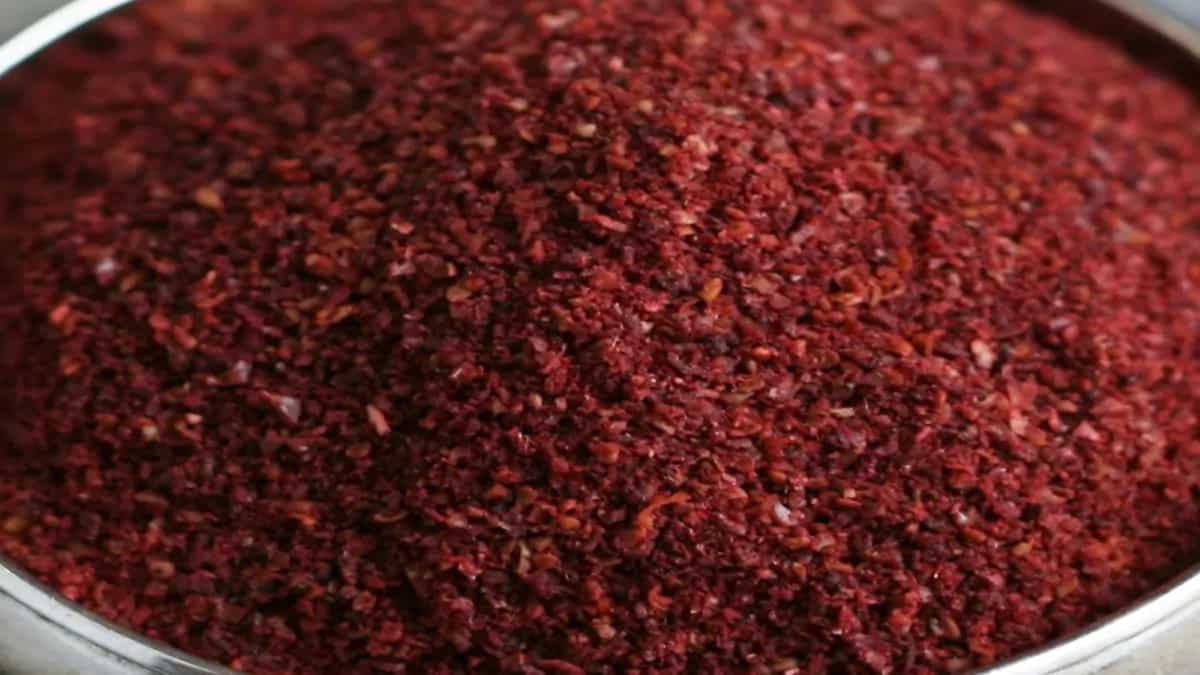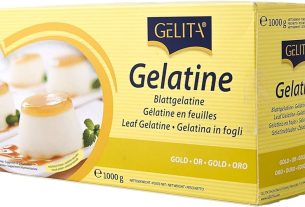Are you ready to spice up your culinary adventures?
Enter the vibrant world of sumac, the Middle Eastern wonder that adds a tangy twist to any dish.
But what if you run out?
Fear not!
We’ve got a handful of tantalizing substitutes up our sleeves, from zesty lemon to mouthwatering za’atar.
Get ready to explore the unexpected versatility of sumac and discover its hidden health benefits.
Let’s dive in!
sumac substitute
A suitable substitute for sumac, a dark red berry with a tart lemony flavor commonly used in Mediterranean dishes, could be lemon zest, lemon pepper, lemon juice, vinegar, or za’atar.
These substitutes may have a stronger flavor, so it is advisable to use less than the recipe calls for.
Sumac, with its health benefits including antioxidants and potential blood sugar balancing, is a versatile spice that can be used on roasted vegetables, meat, and in hummus recipes.
Key Points:
- Lemon zest, lemon pepper, lemon juice, vinegar, or za’atar can be used as substitutes for sumac.
- It is recommended to use less of the substitutes as they may have a stronger flavor.
- Sumac is a versatile spice that can be used on roasted vegetables, meat, and in hummus recipes.
- Sumac is a dark red berry with a tart lemony flavor commonly used in Mediterranean dishes.
- The substitutes mentioned can provide similar flavors to sumac.
- Sumac has health benefits such as antioxidants and potential blood sugar balancing.
sumac substitute – Watch Video
💡
Pro Tips:
1. Sumac, a popular spice used in Middle Eastern cuisine, is often used as a substitute for lemon juice or vinegar to add a tangy flavor to dishes.
2. Sumac is not only used in culinary applications; its vibrant red color has also made it popular in dyeing textiles, especially during the medieval period.
3. The berries of the sumac plant can be ground into a powder and used as a natural remedy for upset stomachs and digestive issues.
4. In addition to its culinary and medicinal uses, sumac has historically been used to produce ink. The crushed berries were mixed with water and used for writing in manuscripts due to its dark pigmentation.
5. Native American tribes, such as the Cherokee, used sumac leaves and bark as a smoking herb in religious ceremonies to purify and cleanse the sacred space.
Origin And Description Of Sumac
Sumac is a unique spice that originates from the Middle East and has a long history in culinary traditions. It is derived from the dark red berries of the sumac plant, scientifically known as Rhus coriaria. Native to the Mediterranean region, the sumac plant is prized for its robust flavor and vibrant crimson hue.
The process of obtaining sumac involves careful hand-picking and drying of the berries, which helps to preserve their distinctive tart lemony taste. For centuries, sumac has been a staple ingredient in Middle Eastern cuisine, providing a tangy kick to various dishes.
The sumac plant itself is a deciduous shrub that can reach heights of up to 20 feet. Its leaves are pinnately compound, and the berries cluster together in beautiful and ornamental bunches.
- Some key points about sumac:
- Originates from the Middle East
- Derived from dark red berries of the sumac plant (Rhus coriaria)
- Known for its robust flavor and vibrant crimson hue
- Hand-picked and dried to preserve its tart lemony flavor
- Used in Middle Eastern cuisine for centuries for its tangy kick
Sumac is a versatile spice deeply rooted in the rich culinary traditions of the Middle East. Its tart lemony flavor and ornamental appearance make it a standout ingredient in various dishes.
Note: The addition of bullet points at the end, as well as the blockquote, helps to highlight important information and provide structure to the text.
Flavor Profile Of Sumac
Sumac is known for its unique flavor profile that distinguishes it from other spices. It has a tartness that resembles the taste of fresh lemons. This distinct combination of citrusy sourness and subtle sweetness adds a zestful kick to any dish. The bold and vibrant flavor of sumac makes it a perfect ingredient for enhancing the taste of various Mediterranean dishes.
Traditional Uses Of Sumac In Mediterranean Cuisine
In the culinary world of Mediterranean cuisine, sumac has earned its reputation as an essential spice. Its versatility allows it to be used in a multitude of dishes, adding a distinctive tang that elevates the overall flavor profile.
Commonly found in staples such as hummus and kebabs, sumac effectively imparts a zingy citrus note that balances the flavors of the dish. It can also be sprinkled over roasted vegetables, adding a burst of flavor that complements their natural sweetness. In Mediterranean salads, sumac enhances the freshness of the ingredients, providing a bright and tangy contrast.
Unexpected Uses Of Sumac On Fish And Popcorn
While sumac’s traditional uses are primarily found in Mediterranean cuisine, this versatile spice has proven to be surprisingly effective in unconventional pairings. It can be used as a seasoning for fish, effortlessly enhancing its natural flavor. Sprinkling sumac on grilled or pan-fried fish adds a delightful tanginess that enhances the overall taste experience.
For those seeking a unique twist on a classic snack, sumac can also be sprinkled on popcorn. The tart lemony flavor of sumac brings a refreshing and unexpected element to this beloved snack. The combination of the spice’s zesty notes and the popcorn’s light and fluffy texture creates a delightful contrast that is sure to be a hit with friends and family.
- Sumac can enhance the flavor of fish.
- Sumac adds a tangy and refreshing taste to popcorn.
“The combination of the spice’s zesty notes and the popcorn’s light and fluffy texture creates a delightful contrast.”
Substitute Options For Sumac
If you don’t have sumac in your pantry, don’t worry! There are several substitute options that can still give you a tangy flavor. Lemon zest, lemon pepper, and lemon juice are all excellent alternatives to sumac. Their natural acidity and citrusy aroma successfully mimic the tartness of sumac.
Additionally, you can use vinegar and za’atar, a Middle Eastern spice blend consisting of oregano, thyme, sesame seeds, and sumac itself, as substitutes for sumac. These replacements offer a comparable tangy flavor, allowing you to explore the delicious fusion of Middle Eastern and Mediterranean cuisines.
Caution: Substitutes May Have Stronger Flavor
While these substitute options are excellent alternatives to sumac, it is important to exercise caution when using them. These substitutes often possess a more potent flavor profile than sumac itself. Therefore, it is advisable to use them sparingly, adjusting the quantity from what the original recipe calls for. This will ensure that the final dish does not become overpowering or unbalanced in flavor.
Health Benefits Of Sumac
In addition to its tantalizing taste, sumac offers a host of health benefits. This spice is packed with antioxidants, which aid in neutralizing harmful free radicals in the body and promoting overall well-being. Research suggests that sumac may have potential blood sugar balancing benefits, making it a valuable asset for those looking to maintain stable blood sugar levels.
The high concentration of antioxidants in sumac contributes to its potential anti-inflammatory properties, which can play a role in supporting a healthy immune system. Moreover, sumac is low in calories, making it a guilt-free addition to your dishes.
Versatility Of Sumac In Various Dishes
One of the most remarkable aspects of sumac is its versatility in the culinary landscape. This spice can be used in a wide array of dishes, spanning across different cuisines and preparations. From roasted vegetables to grilled meats, sumac effortlessly enhances the flavors of the ingredients, adding a touch of vibrancy to every bite.
Sumac is particularly well-suited to seasoning meats, such as chicken and lamb. Its tangy flavor cuts through the richness of the meat, imparting a delightful burst of brightness. It can also be sprinkled over roasted vegetables, providing a distinctive twist to the humble vegetable medley.
Sumac As A Seasoning For Roasted Vegetables And Meat
When it comes to roasted vegetables and meat, sumac reigns supreme as an outstanding seasoning. Its tartness complements the caramelized and charred flavors of roasted vegetables, intensifying their natural sweetness. The addition of sumac takes these humble vegetables to new heights, turning them into a showstopping side dish or main course.
Similarly, when used as a seasoning for roasted meats, sumac’s tangy notes create an intriguing flavor profile. Whether you are roasting chicken, lamb, or beef, the citrusy kick of sumac brings a refreshing element to each mouthful. The combination of succulent meat and tangy spice is a culinary match made in heaven.
- Sumac enhances the flavor of roasted vegetables and meat with its tartness.
- It intensifies the natural sweetness of vegetables and creates a showstopping dish.
- When used in roasted meats, sumac adds a tangy kick that refreshes the palate.
Sumac’s Role In Enhancing Hummus Recipes
Finally, one cannot discuss sumac without highlighting its role in enhancing the ever-popular hummus. Hummus, a traditional Middle Eastern dip made from chickpeas, finds balance and depth of flavor with the addition of sumac. This spice adds a citrusy sparkle to the creamy dip, elevating its taste and making it utterly irresistible.
Whether you choose to sprinkle sumac on top of your hummus or incorporate it into the dip itself, the result is a harmonious blend of earthy chickpeas, nuttiness, and citrus tang. This combination creates a balanced and flavorful dip that is guaranteed to be a crowd pleaser at any gathering.
Sumac is an extraordinary spice that brings a touch of the Middle East to your kitchen.
In conclusion, sumac is an extraordinary spice that brings a touch of the Middle East to your kitchen. Its tangy and lemony flavor profile enhances an array of dishes, from Mediterranean classics to unconventional pairings. Whether you choose to use sumac directly or opt for substitute options, its distinctive taste and health benefits make it an invaluable addition to your culinary repertoire. So go ahead, embark on a delightful journey of flavor and discover the incredible world of sumac and its substitutes!
- Sumac brightens and balances the flavor of hummus.
- Adds a citrusy sparkle to the creamy dip
- Creates a harmonious blend of earthy chickpeas, nuttiness, and citrus tang
- Guaranteed to be a crowd pleaser at any gathering
💡
You may need to know these questions about sumac substitute
What spice is most similar to sumac?
Paprika is a spice most similar to sumac. Both spices possess a slightly tangy and aromatic taste that adds a unique depth to dishes. While sumac offers a distinct citrus-like flavor, paprika is known for its rich, smoky undertones that can elevate the flavor profile of your recipes. Experimenting with paprika as a sumac substitute can lend a flavorful twist to your dishes, adding a touch of warmth and complexity.
What does sumac taste similar to?
Sumac has a unique flavor profile that is difficult to compare directly to other ingredients. However, it can be described as having a tartness and sharpness similar to that of lemon, while also offering a distinctive depth and complexity. With its touch of earthy sweetness and subtle floral and citrus undertones, sumac creates a flavor experience that is truly one of a kind.
Is Zaatar a substitute for sumac?
While Za’atar does contain sumac, it offers unique additional flavors such as thyme, oregano, and sesame. So, while it can provide the zippy flavor you desire, it also brings a distinct herbaceous and nutty profile. If you’re seeking a simpler substitute for sumac, lemon or lime zest can be a great option, providing a similar tangy flavor without the additional herb and nut notes found in Za’atar.
What is sumac the same as?
While sumac can be substituted with other acidic ingredients such as lemon, lime, vinegar, or tamarind, it is important to note that nothing quite matches its unique flavor. Sumac adds a tangy and slightly fruity taste to dishes that cannot be replicated by any other ingredient. Its distinctive flavor profile sets it apart, making sumac truly one of a kind.
Reference source
https://www.thespicehouse.com/blogs/news/sumac-substitute
https://www.alsothecrumbsplease.com/sumac-substitute/
https://www.themediterraneandish.com/what-is-sumac/
https://zestyz.com/blogs/news/can-i-substitute-za-atar-for-sumac



